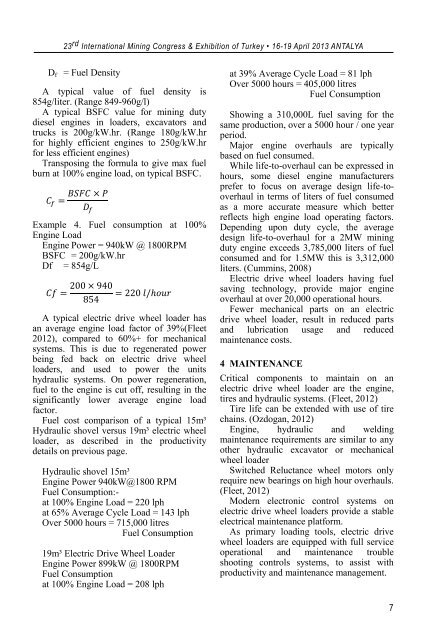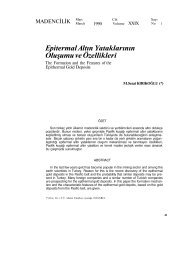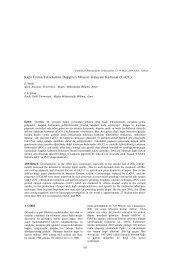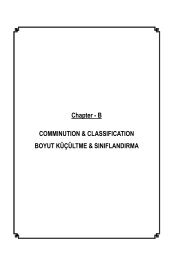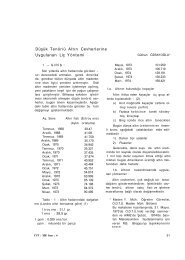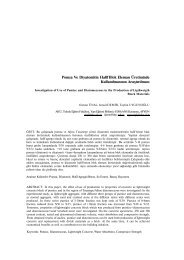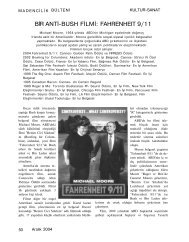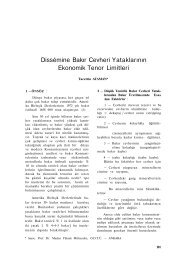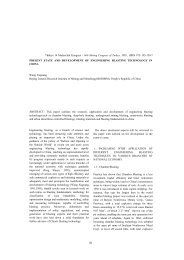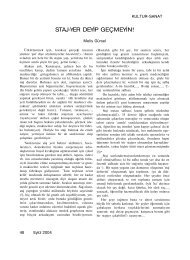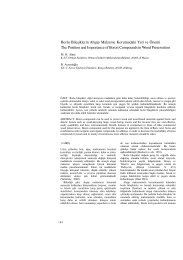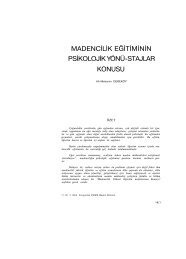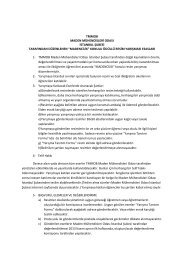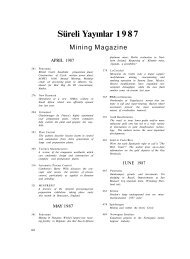A OPEN PIT MINING AÇIK OCAK MADENCİLİĞİ
A OPEN PIT MINING AÇIK OCAK MADENCİLİĞİ
A OPEN PIT MINING AÇIK OCAK MADENCİLİĞİ
Create successful ePaper yourself
Turn your PDF publications into a flip-book with our unique Google optimized e-Paper software.
23 rd <br />
D f = Fuel Density<br />
A typical value of fuel density is<br />
854g/liter. (Range 849-960g/l)<br />
A typical BSFC value for mining duty<br />
diesel engines in loaders, excavators and<br />
trucks is 200g/kW.hr. (Range 180g/kW.hr<br />
for highly efficient engines to 250g/kW.hr<br />
for less efficient engines)<br />
Transposing the formula to give max fuel<br />
burn at 100% engine load, on typical BSFC.<br />
<br />
<br />
Example 4. Fuel consumption at 100%<br />
Engine Load<br />
Engine Power = 940kW @ 1800RPM<br />
BSFC = 200g/kW.hr<br />
Df = 854g/L<br />
<br />
<br />
<br />
<br />
A typical electric drive wheel loader has<br />
an average engine load factor of 39%(Fleet<br />
2012), compared to 60%+ for mechanical<br />
systems. This is due to regenerated power<br />
being fed back on electric drive wheel<br />
loaders, and used to power the units<br />
hydraulic systems. On power regeneration,<br />
fuel to the engine is cut off, resulting in the<br />
significantly lower average engine load<br />
factor.<br />
Fuel cost comparison of a typical 15m³<br />
Hydraulic shovel versus 19m³ electric wheel<br />
loader, as described in the productivity<br />
details on previous page.<br />
Hydraulic shovel 15m³<br />
Engine Power 940kW@1800 RPM<br />
Fuel Consumption:-<br />
at 100% Engine Load = 220 lph<br />
at 65% Average Cycle Load = 143 lph<br />
Over 5000 hours = 715,000 litres<br />
Fuel Consumption<br />
19m³ Electric Drive Wheel Loader<br />
Engine Power 899kW @ 1800RPM<br />
Fuel Consumption<br />
at 100% Engine Load = 208 lph<br />
at 39% Average Cycle Load = 81 lph<br />
Over 5000 hours = 405,000 litres<br />
Fuel Consumption<br />
Showing a 310,000L fuel saving for the<br />
same production, over a 5000 hour / one year<br />
period.<br />
Major engine overhauls are typically<br />
based on fuel consumed.<br />
While life-to-overhaul can be expressed in<br />
hours, some diesel engine manufacturers<br />
prefer to focus on average design life-tooverhaul<br />
in terms of liters of fuel consumed<br />
as a more accurate measure which better<br />
reflects high engine load operating factors.<br />
Depending upon duty cycle, the average<br />
design life-to-overhaul for a 2MW mining<br />
duty engine exceeds 3,785,000 liters of fuel<br />
consumed and for 1.5MW this is 3,312,000<br />
liters. (Cummins, 2008)<br />
Electric drive wheel loaders having fuel<br />
saving technology, provide major engine<br />
overhaul at over 20,000 operational hours.<br />
Fewer mechanical parts on an electric<br />
drive wheel loader, result in reduced parts<br />
and lubrication usage and reduced<br />
maintenance costs.<br />
4 MAINTENANCE<br />
Critical components to maintain on an<br />
electric drive wheel loader are the engine,<br />
tires and hydraulic systems. (Fleet, 2012)<br />
Tire life can be extended with use of tire<br />
chains. (Ozdogan, 2012)<br />
Engine, hydraulic and welding<br />
maintenance requirements are similar to any<br />
other hydraulic excavator or mechanical<br />
wheel loader<br />
Switched Reluctance wheel motors only<br />
require new bearings on high hour overhauls.<br />
(Fleet, 2012)<br />
Modern electronic control systems on<br />
electric drive wheel loaders provide a stable<br />
electrical maintenance platform.<br />
As primary loading tools, electric drive<br />
wheel loaders are equipped with full service<br />
operational and maintenance trouble<br />
shooting controls systems, to assist with<br />
productivity and maintenance management.<br />
7


